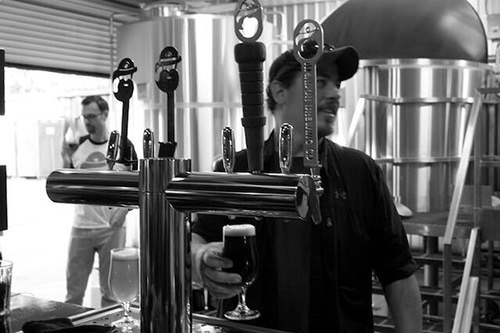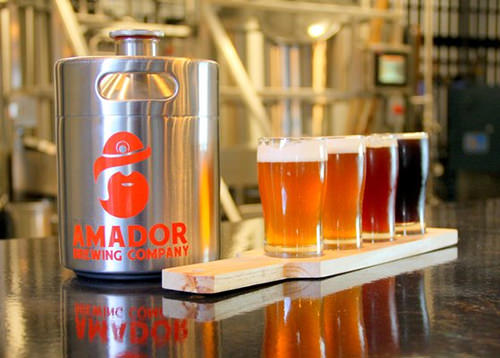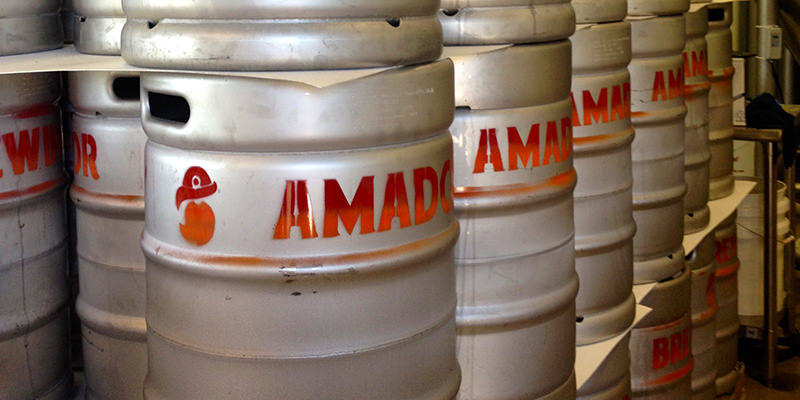All photos by Jen Pritchard
I thought I’d be the one asking questions when I stepped into Amador Brewing Company’s tank-filled tasting room to experience their Monday morning brewing process.
Instead, head brewer KC Sare started things off: “You want a beer?” he asked, a half-full glass of the company’s Night Hike Porter in his hand. “It’s part of my brewing philosophy, always have a beer.”
Not wanting to disrupt the delicate hops balance of the place–both fermented and fermenting–I started with the Amador Light Pale Ale, an herbal ale the color of Coors Light, with a complex flavor that was anything but Rocky Mountain in style.
Sare and co-owner Will Pritchard were working on the Kit Carson Pale Ale, a tropical scented dry-hopped ale. Amador Brewing Company, which opened its doors in April, is a recent addition to the growing number of breweries operating in wine country. From California to Virginia, New York’s Finger Lakes and every grape growing region in between, there’s now a craft brewery to match.
Pritchard and Sare had started the brewing process a few hours before my arrival, and the wort–the sugary base liquid of beer–was bubbling in huge steel kettles.
“Wanna try some?” an assistant asked.
Like most visitors, I leapt at the chance to taste the honeyed and yeasty liquid, a characteristic Pritchard sees as integral to the success of breweries operating in wine country.
“Beer in wine country is a great combination, and it has been for decades,” he says. “Craft beer and fine wine just go together, we’re really talking about the same demographics–people who like to go out and drink different things.”
And he’s right about California’s gold country–a landscape now peppered with wineries— being one of the few spots left for brewers to set up shop that “isn’t some boring light industrial park.”

According to the California Craft Brewers Association there were 554 breweries operating in the Golden State in 2014, with over 200 more in the planning stages. When it comes to wine country, that means Napa (Napa Smith Brewery, Napa Point Brewery, Downtown Joe’s); Sonoma (Russian River Brewing Co., Hopmonk Tavern, Lagunitas); Mendocino (North Coast Brewing, Anderson Valley Brewing, Ukiah Brewing); and the Central Coast (Firestone Walker Brewing Company, Third Street Ale Works, Telegraph brewing) are already taken.
The thirty or so breweries operating in the heart of California wine country are a tiny percentage of the 3,464 breweries that make up the American Craft Beer industry, a sector that grew 17.6% in 2014, according to the National Brewers Association. “Craft Beer,” is defined as “small” and “innovative,” breweries that are not controlled by other alcoholic beverage brands, according to the Brewers Association. These days. those brewers account for a 19.6 billion dollar industry in the US.
Does that mean the dichotomy between hops lovers and grape lovers is shrinking? Sare and Pritchard–who also tends an acre of Zinfandel grapes–argue the separation between the two groups has never been very far apart.
“Brewing and winemaking are both about chemistry,” said Sare, who studied brewing and distilling in Edinborough before brewing at Annheuser Busch. “Beer and wine are both really sensitive to temperature, yeast, and oxygen during fermentation, and you need a lot of lab work to make good, clean beer, just like wine.”
It’s the difference between “clean” beer–brews that are free of volatile bacteria–that makes the distinction between being a fad brewer, or one that lasts for decades after the sour beer craze.
Microbiology sent Sare running just after answering that question–it was time to transfer the Kit Karson Pale Ale to a different gigantic kettle, where it would boil for a few hours before being flash-cooled and sent into a tank to ferment for a week before being ready to drink.

That quick turn around time is perhaps the biggest difference between beer and wine making. While winemakers get one chance to craft the year’s grape harvest into a perfect cuvée, it only takes 14-21 days to turn raw grain and hops into a finished brew. Beer inputs are shelf stable products, so there’s no rush for brewers to use everything they have, unlike wine grapes, which start deteriorating moments after being picked.
The sheer volume of hops varieties, malts, and beer styles rivals those of wine–meaning there’s something for everyone–and aficionados agree: glassware matters with beer too. Glass giant Riedel has even created specialty crystal craft beer glasses. One by one, small brewers are proving all dark beer isn’t as thick as Guinness.
The beers being poured one by one from Amador Brewing Company’s taps are as far from Coors Light as Beaujolais is from Franzia, and perhaps that difference is what inspires alcoholic harmony between Cicerones and Sommeliers in wine country: an appetite for discovering and appreciating the differences.

